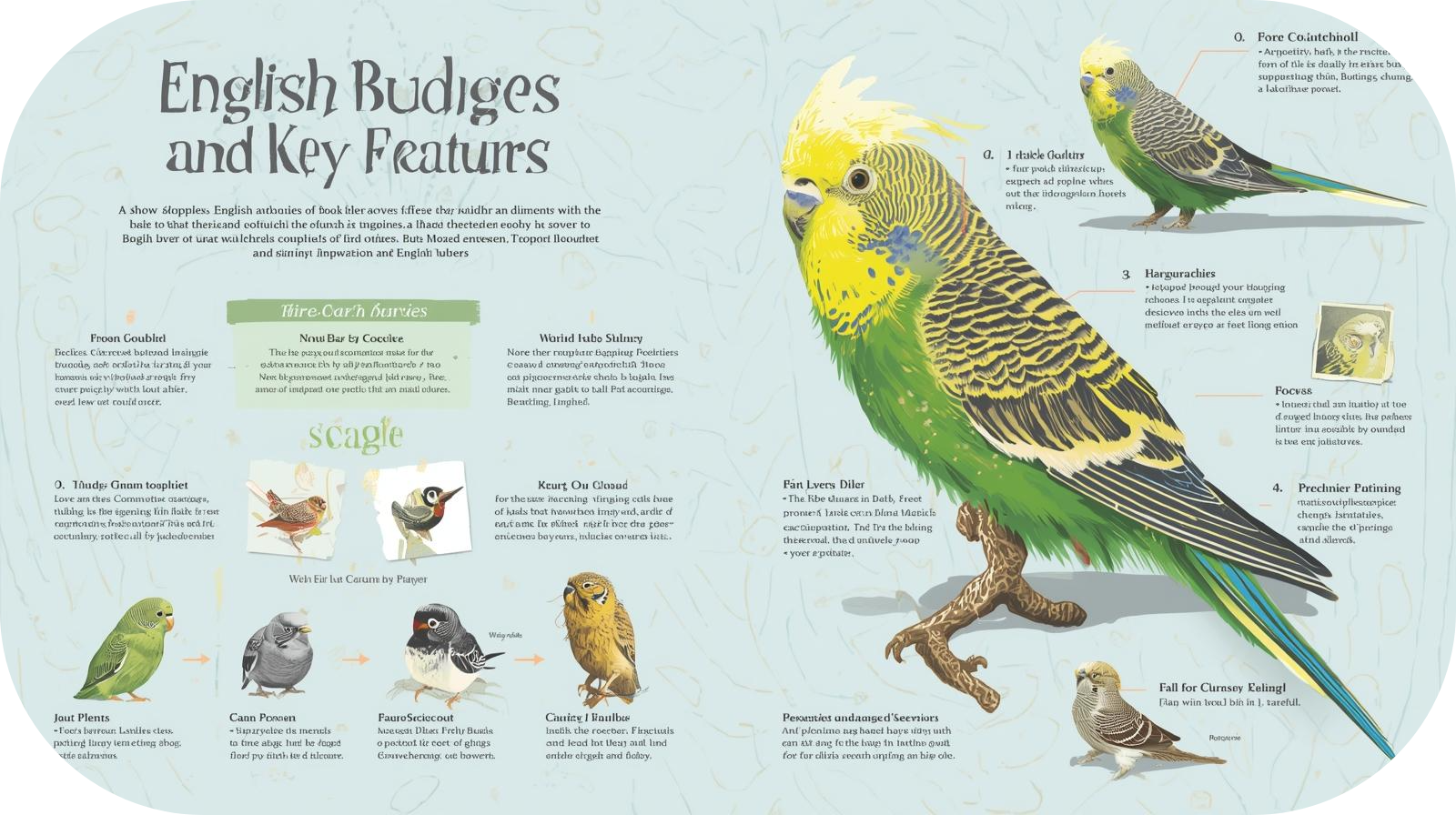
Introduction: Discovering the World of English Budgies
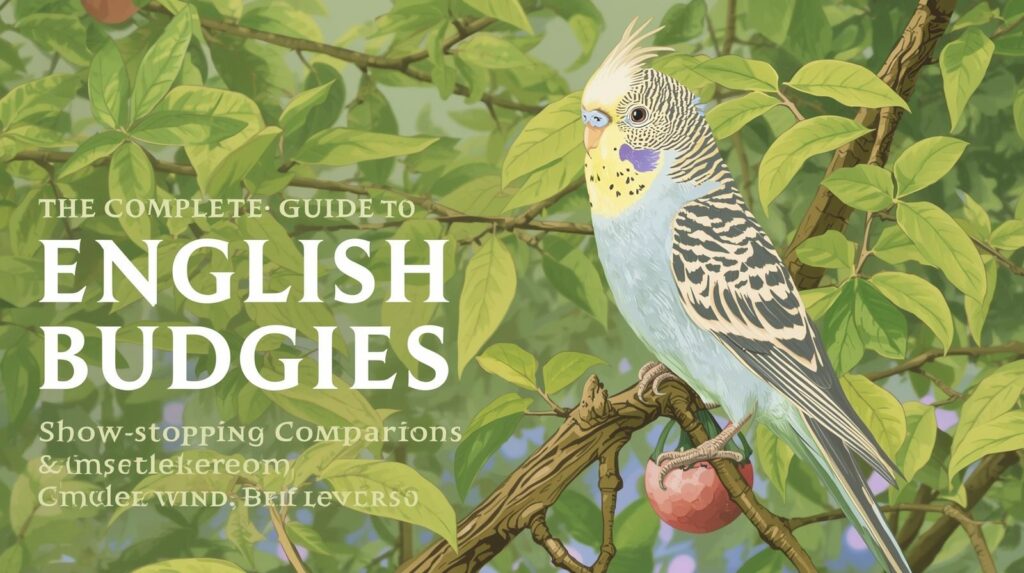
When people in the United States think of a pet bird, they often imagine the common parakeet found in every pet store. But there exists a magnificent variety that represents the pinnacle of selective breeding: the magnificent English Budgies. These amazing birds mix the smarts of parrots with the small size of a little bird. Many fans call them the “gentle giants” of the budgie world.
The journey of English Budgies from wild bird ancestors to show-stopping companions is a fascinating story of aviculture. These birds are different from their wild relatives in Australia.
Breeders have changed them over many generations through careful breeding. Now, they are like living works of art. Their impressive size, luxurious colorful plumage, and remarkably calm disposition make them increasingly popular among bird owners seeking something beyond the ordinary.
This guide will cover all parts of English Budgie care. It will explain the key differences between English and American Budgies. This will also help you choose between show quality and pet quality birds.
Whether you are a first-time bird owner or an experienced bird lover, you will find helpful tips. Learn how to create the perfect home for your bird. Understand their special needs and help these amazing creatures thrive with your care.
Understanding English Budgies – More Than Just a Pretty Face
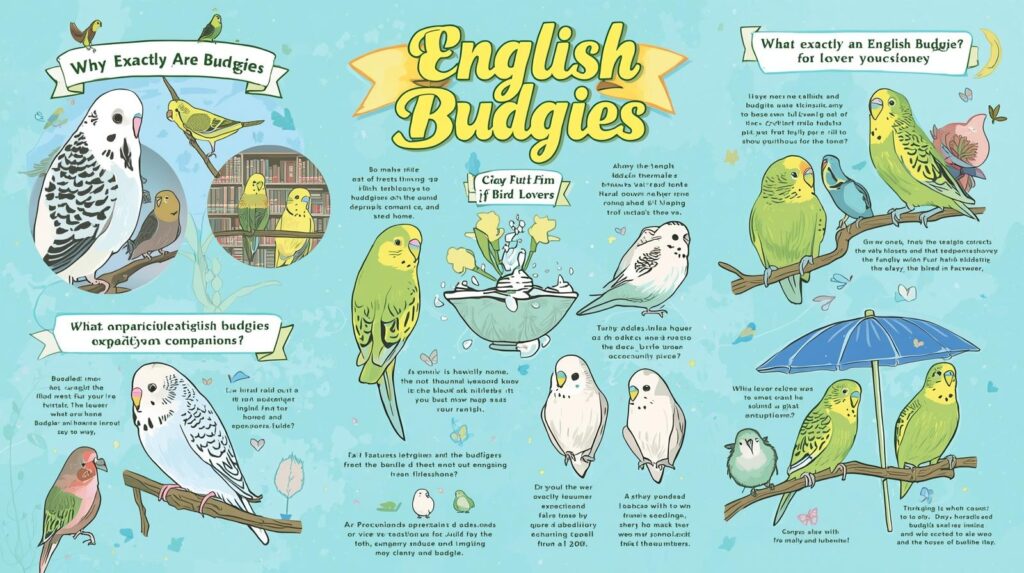
What Exactly Are English Budgies?
Many people mistakenly believe English Budgies represent a different bird species altogether. In reality, they are the same species as their American relatives – Melopsittacus undulatus. They show what happens when many years of selective breeding focus on improving certain traits.
The change from wild birds to today’s show-quality birds started in Victorian England. Aviculturists used the same methods for parakeets as they did for dogs and pigeons.
The fundamental differences between English Budgies and their American relatives stem from this specialized breeding history. While both share common ancestors from the Australian outback, English Budgies have been selectively bred for:
- Enhanced physical characteristics including larger size and more substantial build
- Dramatic feather development, particularly around the head region
- Calmer temperament suitable for exhibition and companionship
- More diverse and intense coloration in their colorful plumage
For bird owners in the United States, it is important to understand this background. This helps explain why English Budgies cost more and need different care than regular pet store parakeets.
The Historical Journey from Wild Bird to Show Stopper
The development of English Budgies represents one of the most successful stories in aviculture history. It began when British breeders started selecting birds with desirable traits, much like horticulturists developing prize roses. Through generations of meticulous pairing, they amplified characteristics that would eventually define the English Budgie standard.
The original wild bird from Australia measures approximately 7 inches in length and weighs around 30 grams. Through selective breeding, English Budgies now typically reach 8.5 to 10 inches in length and can weigh up to 60 grams. This big size difference sets them apart from American parakeets and other small birds often found in pet stores.
Why Choose an English Budgie?
For potential bird owners considering their first pet bird, English Budgies offer several compelling advantages. Their calm demeanor makes them less intimidating for first time bird owners who might feel overwhelmed by more active bird species. Their ability to mimic human speech is often better than that of American budgies. This is due to their larger vocal organs and focused nature.
Many time owners (experienced bird enthusiasts) appreciate English Budgies for their stunning appearance and show potential. The many colors and feather patterns are fascinating for people who study bird genetics and breeding. These birds have a beautiful spangle pattern and striking clearwings. They show a variety of colors that most small birds do not.
English Budgie vs American Budgie: Understanding the Key Differences
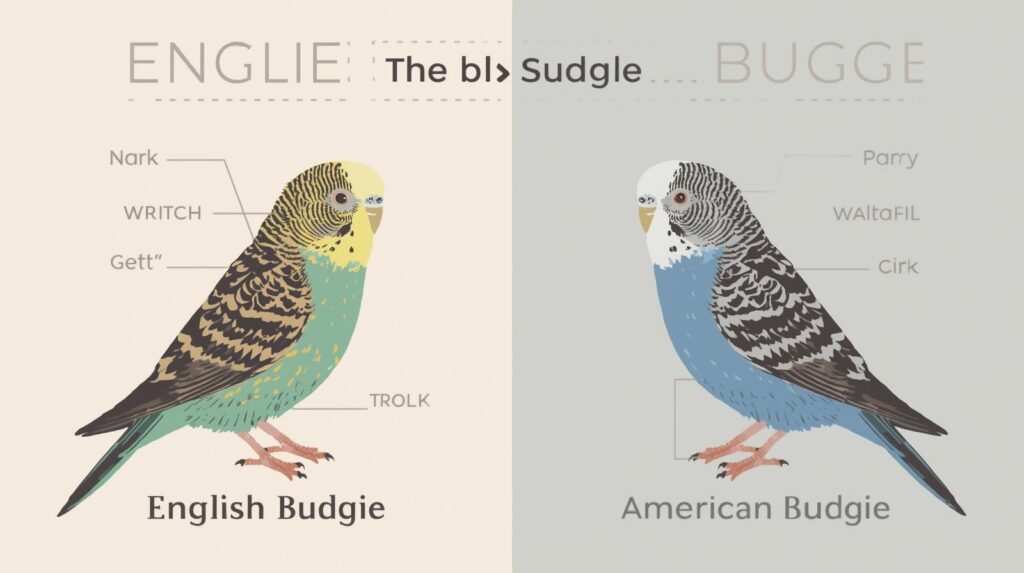
Physical Distinctions: More Than Just Size
When comparing english budgie vs american budgie, the physical differences are immediately apparent to even casual observers. The most noticeable distinction lies in their size and proportions.
American budgies usually measure 6 to 7 inches long. In contrast, English budgies are typically 8 to 10 inches long. Some show birds can be even larger.
The head structure presents another dramatic difference. English Budgies possess broad, substantial heads with prominent foreheads created by their characteristic feather caps. This “fluffy” appearance around their face gives them a distinctive, almost owl-like expression. In contrast, American budgies have smoother, more streamlined heads that reflect their wild ancestors’ aerodynamic needs.
Feather quality and arrangement also differ significantly. English Budgies boast longer, fluffier feathers throughout their bodies, including their tail feathers. This luxurious plumage requires more maintenance but creates their signature “show-stopping” appearance.
American budgies have tighter, smoother feathers that fit closely to their bodies. This helps them be more active and fly better.
Temperament and Behavior: Lap Bird vs Aerial Acrobat
The behavioral differences between these two types might represent the most important consideration for potential owners. English Budgies typically exhibit calm, docile personalities well-suited to being “lap birds.” They often enjoy sitting with their owners for extended periods, accepting gentle petting and interaction with quiet contentment.
American budgies, by comparison, behave more like aerial acrobats. They maintain much of their wild ancestors’ energy levels, preferring constant activity, flight, and exploration. They can form strong bonds with their owners. However, they show affection through active play instead of quiet time together.
For first time bird owners, this temperament difference is crucial. English Budgies generally adapt more easily to handling and tolerate the occasional mistakes that novice owners might make. Their calm nature makes them less likely to panic in new situations, reducing stress for both bird and owner.
Care Requirements: Similar Foundations, Different Emphasis
Both varieties require the same basic care components: appropriate housing, balanced nutrition, and proper veterinary care. However, the emphasis within these categories differs significantly between the two types.
English Budgie care must account for their larger size, less active metabolism, and specialized physical characteristics. They require:
- Larger cages with appropriate bar spacing
- Different perching arrangements to accommodate their substantial size
- Modified diet to prevent obesity while maintaining feather quality
- More frequent monitoring for respiratory issues due to their facial feathering
American budgies, being closer to their wild ancestors, typically have more robust constitutions and higher metabolic rates. They do better with more space to fly, more chances to exercise, and diets with more protein to support their active lives.
Veterinary care considerations also differ between the two types. English Budgies often require more specialized attention from avian vets familiar with the health challenges of highly bred birds. Their small facial feathers can make them more likely to have breathing problems. Their larger size and body type can also lead to some metabolic disorders.
The Complete Guide to English Budgie Care
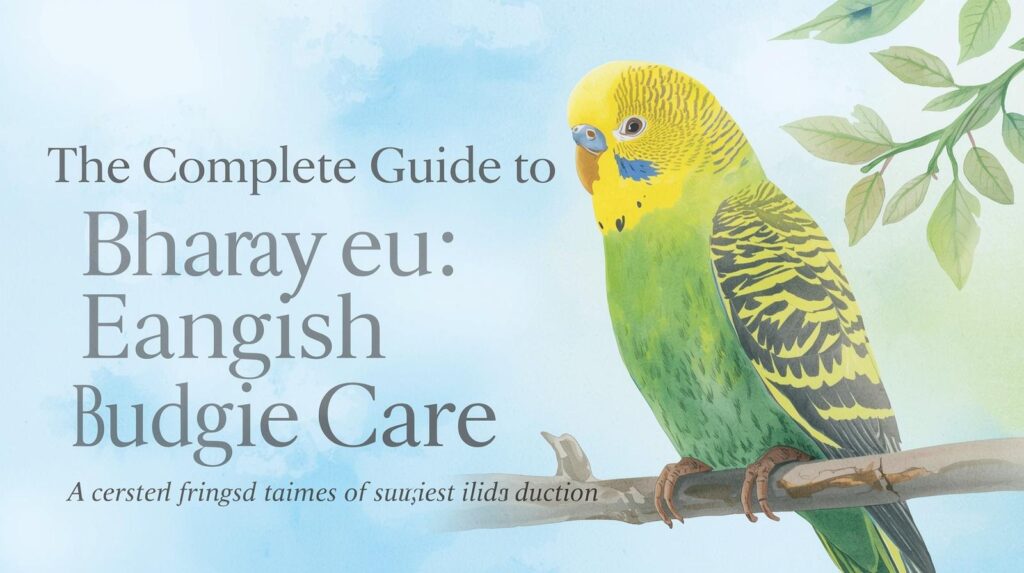
Creating the Perfect Bird Home
Setting up an appropriate bird home represents the first and most crucial step in English Budgie care. These large birds need more space than American birds. A single bird needs a cage that is at least 24″ long, 18″ wide, and 24″ high. Larger enclosures always prove better, particularly for owners who cannot provide daily out-of-cage exercise time.
The interior design of their bird home requires careful consideration. English Budgies need varied perching options to maintain foot health, including natural wood branches of different diameters. Their less active nature means they’re more prone to obesity and foot problems if provided with inadequate perching variety.
Positioning within the home also demands attention. English Budgies, unlike their wild bird ancestors, like bright areas with indirect natural light. Their thick feathers make them more likely to overheat. So, cages should not be in direct sunlight or near heat sources.
Nutritional Needs: Beyond Basic Bird Seed
Proper nutrition forms the cornerstone of effective English Budgie care. Captive English Budgies need a balanced diet to stay healthy and keep their beautiful feathers. Unlike their wild ancestors, who eat different seeds and grasses, these birds rely on specific foods.
A good pellet should make up 60-70% of their diet. This gives balanced nutrition and avoids the problems of selective eating found in seed mixes.
Fresh vegetables should be 20-30% of their daily diet. Focus on dark leafy greens, chopped carrots, and broccoli. You can offer fruits in small quantities as treats, but their high sugar content requires moderation.
Food and water containers require special consideration in English Budgie care. Their fluffy facial feathers can get dirty in deep containers. Using wide, shallow dishes helps keep their feathers clean. Refresh both food and water daily, and clean the containers thoroughly to prevent bacterial growth.
Health Maintenance and Veterinary Care of English budgies
Proactive health management represents perhaps the most overlooked aspect of English Budgie care. These highly bred birds often benefit from establishing relationships with avian vets before problems arise. Many practices offer a first exam for $25. New bird owners can meet the veterinarian and learn about preventive care for their birds.
Regular monitoring should include:
- Weekly weight checks to catch gradual changes
- Feather condition assessment
- Beak and nail health evaluation
- Observation of breathing patterns and sounds
Common health issues in English Budgies often relate to their specialized breeding. Respiratory problems can arise from their compact facial feathering, while liver issues may develop from their tendency toward obesity. Reproductive issues sometimes occur in hens, particularly those bred for extreme show characteristics.
Finding qualified veterinary care proves essential for English Budgie owners. Many general practitioners can manage routine care. However, the complex health issues these birds face often need specialists who know about exotic animals. The Association of Avian Veterinarians provides directories of qualified practitioners throughout the United States.
Show Quality vs Pet Quality: Making the Right Choice
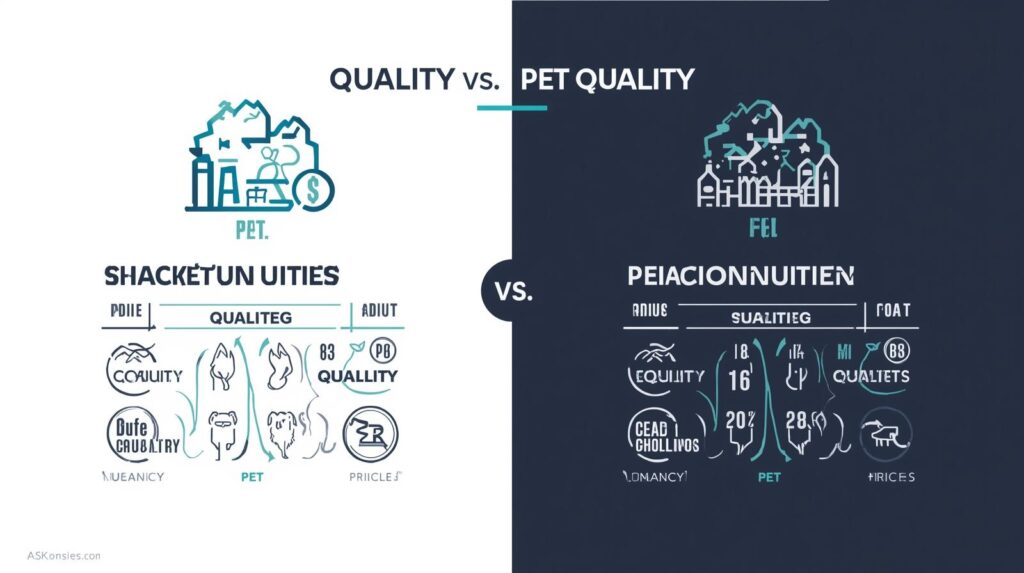
Understanding the distinction of English budgies
For potential owners navigating the world of English Budgies, understanding the difference between show quality vs pet quality birds represents a crucial first step. This distinction does not always show the bird’s health or personality. Instead, it shows how well the bird meets breed standards and its ability to participate in exhibitions.
Show quality English Budgies represent the pinnacle of selective breeding. These birds exhibit near-perfect alignment with breed standards established by organizations like the World Budgerigar Association. They possess ideal physical proportions, flawless feather quality, perfect posture, and coloration that matches specific mutation standards. These birds typically command premium prices and are primarily suitable for breeding and exhibition.
Pet quality English Budgies, while still magnificent birds, may have minor deviations from show standards. These may include:
– Slightly uneven head shapes
– Not-so-perfect feather placement
– Color markings that do not fully match exhibition standards. These birds are great companions and usually cost much less than show-quality ones.
Choosing What’s Right for You
For first time bird owners, pet quality English Budgies often represent the better choice. These birds have all the great traits of the variety.
They are calm, beautiful, and friendly. Plus, they come at a lower price and do not have breeding expectations. They allow newcomers to enjoy the English Budgie experience while learning proper care techniques.
Experienced bird owners interested in exhibition or breeding may prefer show quality specimens. These birds represent opportunities to participate in competitive showing, contribute to breed improvement, and potentially recover some investment through breeding operations. However, they require deeper knowledge and more significant resources than pet-quality birds.
The price difference between these categories can be substantial. Pet quality English Budgies in the United States usually cost between $100 and $300. Show quality birds can cost $500 to $1,500 or more. The price depends on their bloodlines and how well they meet standards.
Ethical Considerations
When choosing between show quality vs pet quality, ethical considerations should inform the decision. The extreme physical characteristics prized in show specimens sometimes correlate with health challenges. The very large heads and abundant feathering that win ribbons can sometimes compromise quality of life.
Responsible bird owners should prioritize health and temperament over perfect conformation. Good breeders will be open about health issues in their birds. They should focus on creating strong, healthy birds that are also beautiful.
English Budgies for First-Time Bird Owners
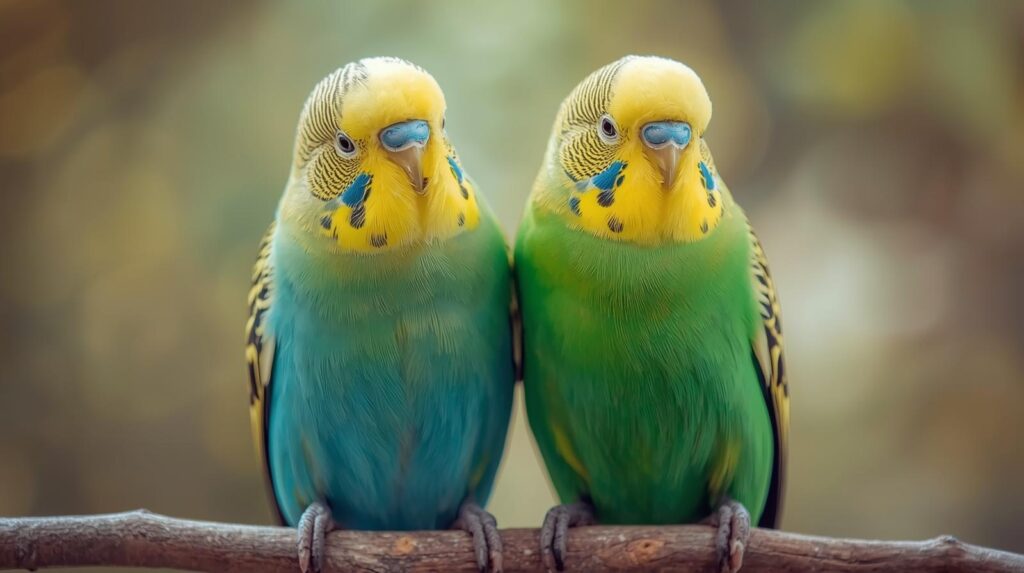
Why English Budgies Make Excellent First Birds
For first time bird owners, English Budgies offer several advantages over other bird species. Their generally calm demeanor makes them less intimidating than more active or larger parrot species. Their size is big enough to hold comfortably but small enough to handle easily. This makes them a great choice for new bird owners.
English Budgies usually have simpler diets and less social needs than other small birds, like green cheeked conures. They enjoy interaction and thrive on socialization. However, they handle alone time better than many parrot species. This is true when they have the right environmental enrichment.
The learning curve for English Budgie care proves more manageable than for many other bird species. Their requirements, while specific, are well-documented and straightforward to implement. This allows first time bird owners to develop confidence and skills before potentially advancing to more challenging species.
Essential Knowledge for New Owners
First time bird owners should focus on mastering several key areas of English Budgie care:
- Understanding Body Language: Learning to interpret feather position, eye pinning, and vocalizations helps owners understand their bird’s emotional state.
- Creating Safe Environments: Bird-proofing the home involves eliminating toxic plants, securing windows and mirrors, and managing other pets.
- Establishing Routines: Consistent daily schedules for feeding, interaction, and sleep help these birds feel secure.
- Recognizing Health Issues: Learning early warning signs of illness enables prompt veterinary care when needed.
Time owners (those with previous bird experience) often note that English Budgies respond exceptionally well to positive reinforcement training. Their intelligence and food motivation make them quick studies when teaching step-up commands, target training, or simple tricks.
Common Beginner Mistakes to Avoid
First time bird owners often encounter predictable challenges when beginning their journey with English Budgies. Awareness of these common pitfalls can smooth the transition for both owner and bird:
- Underestimating Space Needs: The substantial size of English Budgies means they require more spacious accommodations than many newcomers anticipate.
- Overlooking Environmental Enrichment: These intelligent birds need mental stimulation through toys, foraging opportunities, and environmental variety.
- Delaying Veterinary Care: Establishing relationships with avian vets before emergencies arise proves crucial for these sometimes delicate birds.
- Inadequate Socialization: While calmer than many species, English Budgies still require regular, positive interaction to remain bonded and happy.
Advanced Topics for Experienced Bird Owners
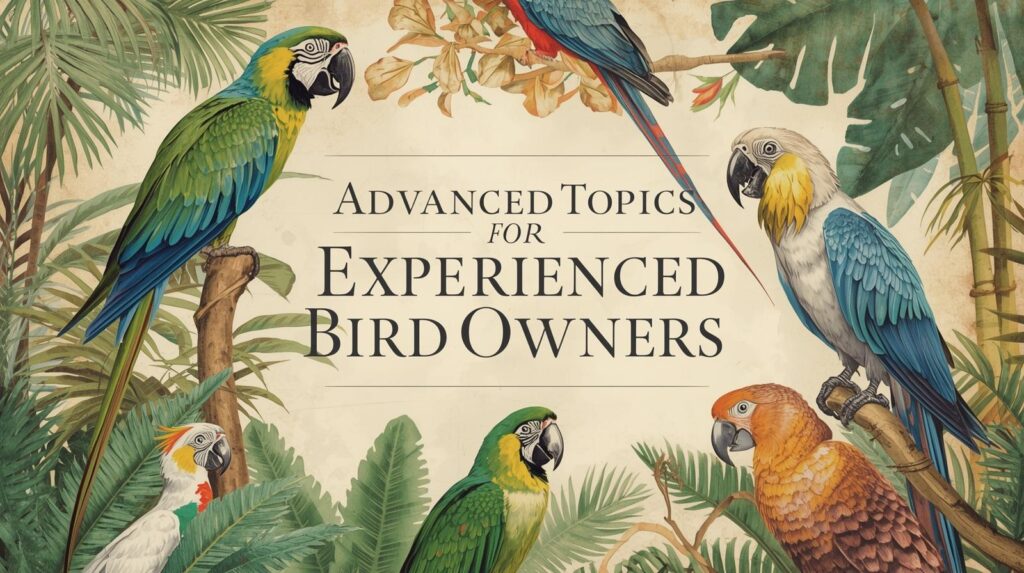
Breeding English Budgies
For experienced bird owners interested in advancing their involvement with English Budgies, breeding represents a natural progression. However, responsible breeding requires extensive knowledge, appropriate resources, and ethical commitment.
Successful breeding programs begin with superior stock. Whether focusing on show quality specimens or particular color mutations, breeders should select birds with excellent health, temperament, and conformity to type. Understanding avian genetics proves essential for predicting outcomes and avoiding detrimental combinations.
The breeding environment requires careful planning. English Budgies need spacious breeding cages, appropriate nesting boxes, and enhanced nutrition during breeding cycles. Breeders must be prepared to hand-feed chicks if parents prove inadequate and have homes lined up for offspring before breeding begins.
Advanced Health Management of English budgies
Experienced bird owners often develop sophisticated health maintenance routines for their English Budgies. These might include:
- Regular laboratory testing including blood work and fecal analysis
- Preventive supplement protocols developed in consultation with avian vets
- Specialized housing with environmental controls for temperature and humidity
- Breeding management to prevent conditions like egg binding in hens
Veterinary care for breeding or show birds often involves more frequent check-ups and specialized consultations. Reproductive issues, feather disorders, and metabolic conditions require expert intervention from practitioners experienced with exotic animals.
Participating in the Show Circuit
For owners of show quality English Budgies, exhibition represents an exciting opportunity to showcase their birds and connect with other enthusiasts. The show circuit in the United States includes local, regional, and national competitions sanctioned by organizations like the American Budgerigar Society.
Preparing birds for shows involves meticulous attention to feather condition, physical fitness, and training. Show birds must tolerate handling by judges and maintain their composure in unfamiliar environments. Successful exhibitors develop extensive knowledge of breed standards and presentation techniques.
Frequently Asked Questions
Q: What is the rarest bird in the world?
A: The critically endangered Spix’s Macaw is one of the rarest. For budgies, rare color mutations like Anthracite are the rarest.
Q: What is the cheapest pet bird?
A: Regular (American) budgies are often the cheapest, starting around $20–$30.
Q: Which color budgie is best?
A: Personality is the same across colors. The best color is the one you love most.
Q: What is the lifespan of English Budgies? A: On average 5–8 years, though some may live longer with great care.
Q: Are English Budgies vocal? A: No, they’re quieter than regular budgies. Their chirps are softer and less frequent.
Conclusion: The Joy of English Budgie Ownership

The world of English Budgies offers something for every level of avian enthusiast. For first time bird owners, they provide a manageable introduction to bird keeping with their calm dispositions and relatively straightforward care requirements. For experienced bird owners, they present opportunities for exhibition, breeding, and the appreciation of avicultural artistry.
Understanding the key differences between english budgie vs american budgie helps potential owners make informed decisions about which type best suits their lifestyle and expectations. The choice between show quality vs pet quality determines both the initial investment and the potential activities available to owners.
Proper English Budgie care requires commitment to appropriate housing, nutrition, and health management. Establishing relationships with qualified avian vets ensures these sometimes delicate birds receive appropriate veterinary care throughout their lives. Creating a proper bird home forms the foundation for their wellbeing and allows their full beauty and personality to flourish.
Whether you’re drawn to their spectacular colorful plumage, their impressive long tailed silhouette, or their reputation as gentle companions, English Budgies offer a unique and rewarding pet ownership experience. Their transformation from humble wild bird ancestors to living art represents one of aviculture’s greatest achievements – and their potential as companions represents an ongoing joy for bird owners worldwide.

Leave a Reply